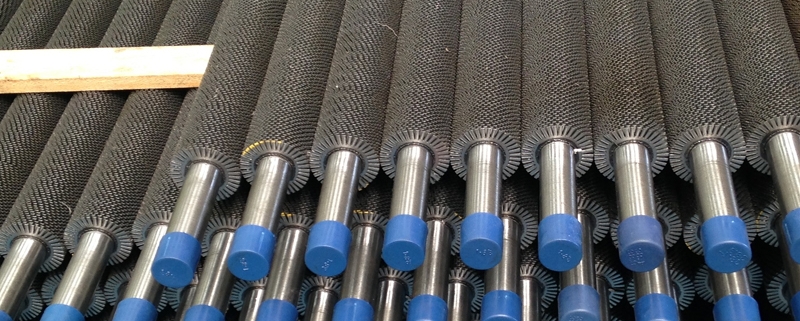Руководство по оребренным трубам: повышение эффективности теплопередачи
Введение
А ребристая трубка максимизирует эффективность теплопередачи между двумя жидкостями в теплообменниках. Эти трубки улучшают тепловые характеристики за счет увеличения площади поверхности, доступной для теплообмена. Независимо от того, используются ли они на электростанциях, в системах HVAC или химической обработке, ребристые трубки значительно повышают эффективность теплопередачи. В этом руководстве будут подробно рассмотрены ребристые трубки, их стандарты и марки, типы ребер, материалы, спецификации и подходящие размеры трубок.
Что такое ребристые трубы?
Оребренные трубы состоят из базовой трубы с удлиненными ребрами, прикрепленными к ее внешней стороне. Ребра увеличивают площадь поверхности, улучшая скорость теплопередачи. Эти трубы необходимы в приложениях, требующих эффективного теплообмена и ограниченного пространства.
Стандарты и оценки
Для классификации оребренных труб в зависимости от материала, конструкции и области применения используются различные стандарты и марки:
EN 10216-2: Бесшовные трубы для работы под давлением:
P235GH TC1/TC2: Используется в котлах и сосудах под давлением.
P265GH TC1/TC2: Обеспечивает более высокую прочность в условиях высокого давления.
Стандарты АСТМ:
АСТМ А179: Трубы из низкоуглеродистой стали для теплообменников и конденсаторов.
АСТМ А192: Аналогичен A179, но рассчитан на более высокое давление.
ASTM A213: Бесшовные трубы из ферритной и аустенитной легированной стали, в том числе:
TP304/304L: Широко используется из-за своей коррозионной стойкости и простоты сварки.
TP316/316L: Предпочтительно в средах с повышенным риском коррозии.
EN 10216-5: Трубы из нержавеющей стали:
EN 1.4301 (304): Европейский эквивалент ASTM TP304, устойчив к коррозии.
EN 1.4307 (304L): Низкоуглеродистый вариант 1.4301, идеально подходящий для сварки.
EN 1.4401 (316): Обеспечивает улучшенную устойчивость к хлоридам.
EN 1.4404 (316L): Низкоуглеродистая версия 1.4401, пригодная для сварки.

Ребристые трубы
Типы плавников
Ребра, используемые в оребренных трубах, могут различаться в зависимости от способа крепления и области применения:
Встроенные плавники: Механически встраивается в поверхность трубки, обеспечивая прочное соединение и высокую тепловую эффективность.
Сварные ребра: Ребра приварены к трубке, что обеспечивает долговечность и механическую прочность, что идеально подходит для суровых условий.
Экструдированные ребра: Ребра выдавливаются из материала трубки, обеспечивая равномерные свойства теплопередачи.
Материалы для плавников
Материал ребер выбирается в зависимости от желаемых тепловых характеристик и условий окружающей среды:
Алюминиевые сплавы:
АА1100: Известен своей превосходной теплопроводностью и коррозионной стойкостью.
АА1080, АА1060, АА1050: Эти марки обладают схожими свойствами с небольшими различиями в прочности и проводимости.
Технические характеристики: размеры трубки, высота ребра, толщина и плотность
Эффективность оребренных труб зависит от различных факторов, включая наружный диаметр, толщину стенки, высоту ребра, толщину и количество ребер на дюйм или метр.
Наружный диаметр трубки (OD): Оребренные трубы обычно доступны с внешним диаметром от 16 мм - 219 мм (приблизительно 5/8″ - 8,625″). Этот диапазон охватывает большинство стандартных применений.
Толщина стенки трубы: Толщина стенки труб, подходящих для оребрения, обычно колеблется от 1 мм до 8 мм. Более тонкие стенки чаще встречаются в приложениях, где вес и теплопроводность имеют решающее значение. Для сравнения, более толстые стенки используются в средах с высоким давлением.
Высота плавника: Обычно варьируется от 6 мм - 30 мм. Более высокие ребра увеличивают площадь поверхности, но могут привести к более значительным перепадам давления.
Толщина ребра: Диапазон от 0,2 мм - 0,6 мм. Более толстые ребра обеспечивают большую долговечность, но могут немного снизить тепловую эффективность.
Количество ребер на дюйм (FPI) или на метр (FPM) обычно составляет между 8-16 ИПП или 250–500 футов в минуту. Более высокая плотность обеспечивает большую площадь поверхности, но также может увеличить перепад давления.
Длина оребренных секций: Ребристая часть трубки может быть изготовлена по индивидуальному заказу, стандартная длина варьируется от 1 метр - 12 метров.
Применение и преимущества
Ребристые трубы используются в различных отраслях промышленности благодаря своим превосходным возможностям теплопередачи:
Выработка энергии: Используется в экономайзерах и котлах для улучшения рекуперации тепла и повышения эффективности.
Системы отопления, вентиляции и кондиционирования: Повышение производительности теплообменников, что способствует лучшему контролю температуры и экономии энергии.
Химическая обработка: В реакторах и конденсаторах они способствуют эффективному тепловому управлению, оптимизируя условия реакции и качество продукции.
Часто задаваемые вопросы (FAQ)
1. Каково назначение оребренных труб?
Ребристые трубы увеличивают площадь поверхности теплообменников, повышая эффективность теплопередачи между жидкостями.
2. Какие материалы чаще всего используются для изготовления ласт?
Алюминиевые сплавы, такие как AA1100, AA1080, AA1060 и AA1050, широко используются благодаря их превосходной теплопроводности и коррозионной стойкости.
3. Каковы общепринятые стандарты для оребренных труб?
Оребренные трубы изготавливаются в соответствии со стандартами, такими как EN 10216-2 для бесшовных труб и ASTM A179, A192 и A213 для различных областей применения.
4. Как высота и плотность ребер влияют на производительность?
Более высокие ребра увеличивают площадь поверхности для теплопередачи, в то время как количество ребер на дюйм или метр влияет на общую эффективность. Однако более высокая плотность может также увеличить падение давления.
5. Каковы типичные области применения оребренных труб?
Оребренные трубы широко используются в электроэнергетике, системах отопления, вентиляции и кондиционирования воздуха, а также в химической промышленности для повышения эффективности теплопередачи.
6. Какова типичная длина оребренной трубы?
Длина оребренной части трубы обычно составляет от 1 до 12 метров в зависимости от области применения.
Заключение
Ребристые трубы необходимы в системах, где эффективная теплопередача имеет решающее значение. Понимание различных типов ребер, материалов и спецификаций позволяет инженерам выбирать наиболее подходящую ребристую трубу для своего применения, обеспечивая оптимальную производительность, долговечность и экономическую эффективность.
При выборе оребренных труб важно учитывать особые требования вашей системы, такие как рабочая температура, давление и используемые жидкости. Это может обеспечить наилучшую возможную тепловую эффективность и производительность системы.
Консультации со специализированным производителем или поставщиком настоятельно рекомендуются для индивидуальных решений и более подробной информации о ребристых трубах. Они могут предоставить экспертные рекомендации и помочь вам выбрать идеальную конфигурацию ребристых труб.




